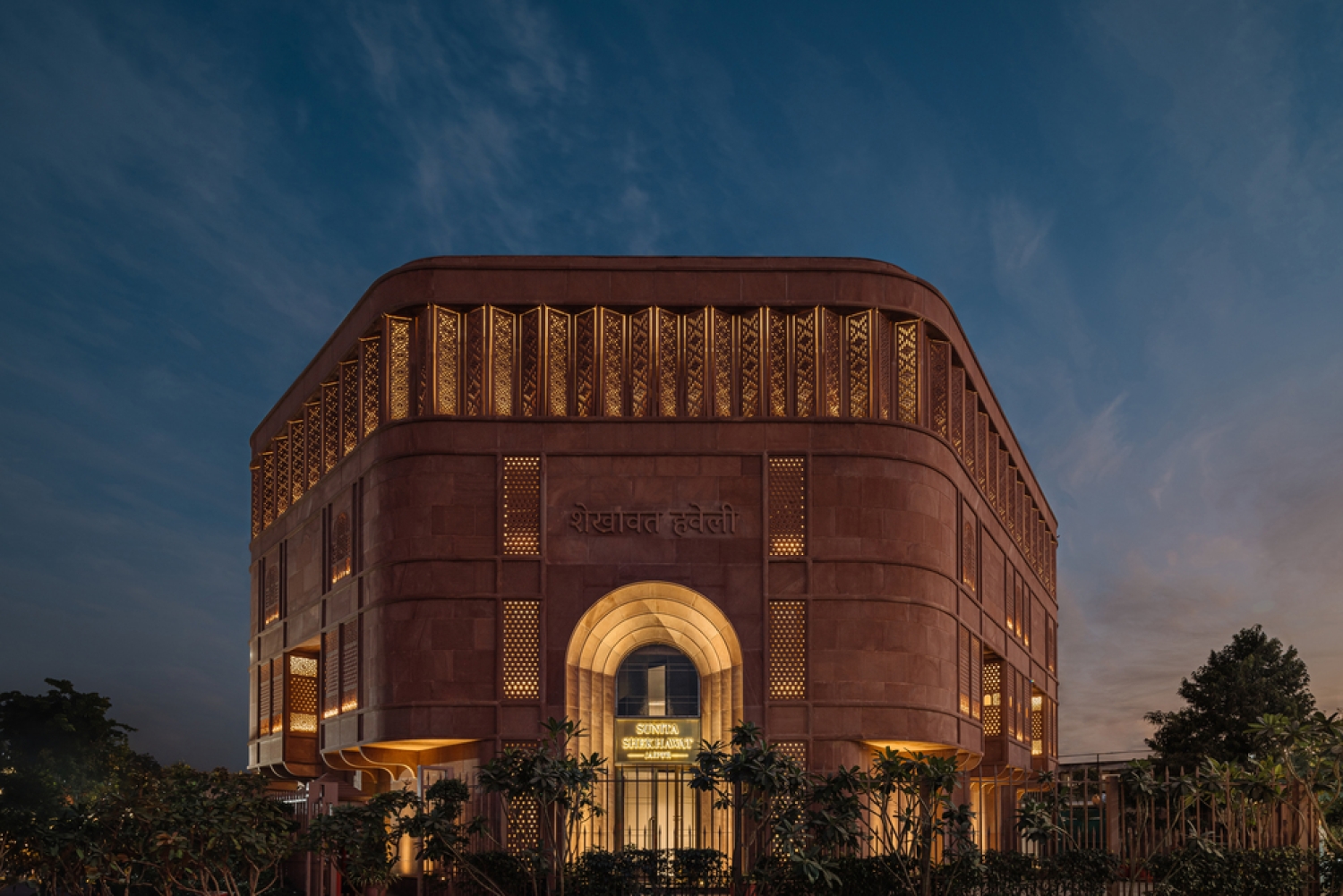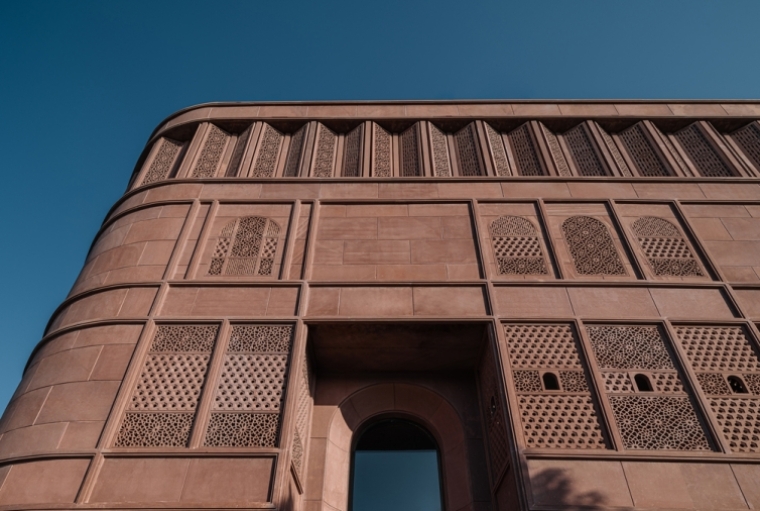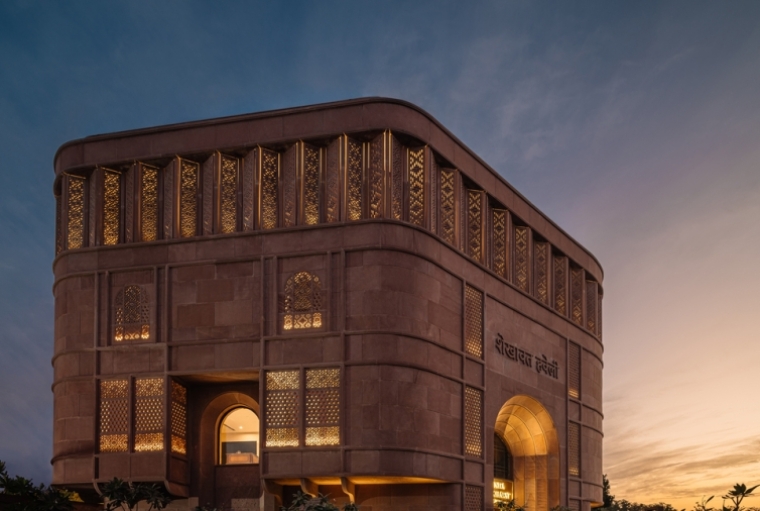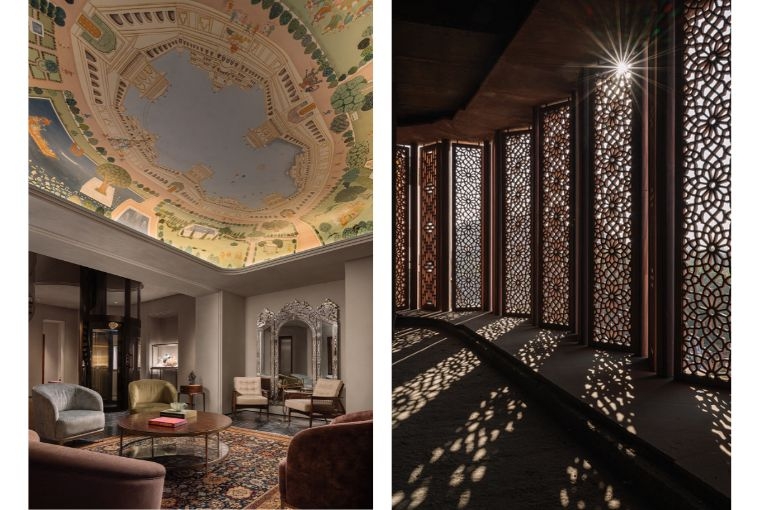

The art of Meenakari or enamel work is an age-old technique renowned for its vibrant and intricate designs on metal surfaces. While enamel work originated in Persia, it has flourished in India, particularly in Rajasthan where it is passed down through the generations and deeply embedded in the region's artistic legacy. This 16th-century art serves as the foundation for the work of well-known Indian jewellery designer, Sunita Shekhawat. Her eponymous brand lends a fresh spin to the age-old tradition with timeless yet contemporary jewellery. Studio Lotus’ design for the brand’s flagship store and Museum of Meenakari in Jaipur pays homage to this approach; a nod to the region's vibrant cultural heritage amidst a fast-evolving cosmopolitan landscape.

ADAPTIVE REUSE
An existing concrete shell had already been erected on site when Studio Lotus was brought onboard. The studio was given carte blanche to pull the structure down and treat the site as a blank canvas. Since it had only recently been cast in concrete, the architects decided to work with the existing shell, in line with their design philosophy of minimising the embodied carbon footprint.
CRAFT, DETAIL, AND BEAUTY
With its wide floorplate and tall ceilings, the lower ground floor lends itself well to the exclusive, by- appointment-only, bespoke nature of the business, and of the product too—the lack of natural light being conducive to the controlled lighting necessary for jewellery display. The first experience is that of a library- cum-lounge space that further leads guests into one of four private pods, designed for one-on-one client interactions. The floor further accommodates a jewellery finishing unit, strongrooms, workshops for karigars, and ancillary spaces for accounts and sales. The planning of the retail space circulation allows for discreet, private servicing of all these pods through a service corridor that wraps itself around their external periphery, ensuring that guests have a highly personalised experience, with a sense of mystery to it.
The pods are clad in an off-white ‘araish’ lime stucco, their semi-vaulted ceilings embellished with frescoes by artists specialising in miniature painting. Developed over several months in-situ by 12 artisans, the frescoes depict vignettes of the region’s architecture and flora and fauna. The outcome—a jewel-like expression of hand-crafted luxury that celebrates the brand’s ethos—is a testament to the skills of the artisans, who’ve interpreted them on an unfamiliar scale and medium; a synergistic collaboration between the architects, the client, and Nisha Vikram of CraftCanvas. The remaining surfaces are monochromatic, so as to have no distractions at eye-level from the intricately-crafted jewellery on display.

IDENTITY & FACADE ARTICULATION
Programmatically, the ground floor houses a museum-gallery, with the store located one floor below and the offices a floor above. The second floor is intended for bringing in like-minded luxury brands, and the top floor, with its panoramic views of the nearby Rajmahal Palace, is designed for use as a restaurant.
The identity of the building is shaped by multiple historic influences of the region—Rajputana, Mughal, and Art Deco—to create a unique composite distinct from any particular style. This new vocabulary mirrors Sunita Shekhawat’s own design approach to her jewellery, which, while rooted in tradition, crosses over seamlessly into European and other contemporary iterations.
The oddly shaped footprint was externally articulated by bevelling the balconies and subsequently devising a form that intricately layers patterns and details that draw from different periods, woven together into one cohesive image. Externally, the ground and first floors are articulated to read as one through a double- height entrance arch in elevation. Clad in hand-carved Jodhpur red sandstone, the facade harks to Sunita’ Shekhawat’s roots in Jodhpur. While quite distinct in expression, it fits seamlessly into the pink palette synonymous with Jaipur’s urban fabric.

FUNCTIONAL PROGRAMME: THE MUSEUM GALLERY
On the inside, the client’s three floors are unified through a striking sculptural staircase that winds through the centre of the space. The original brief outlined the retail space occupying the ground floor, the basement to house offices and karigars’ workshops, and the remaining floors to be let out. The studio suggested to the client, the idea of using the ground level as an opportunity for the Sunita Shekhawat brand to own a storytelling space on the art of enamelling—a fitting way of giving back to the arts and cultural heritage of the city—through the introduction of a museum-gallery that traces the provenance and history of Meenakari craftsmanship. This distinct addition not only serves as the fulcrum of the experience, but also elevates the brand from a jewellery label to a custodian of the craft. The museum experience has been designed by Sidhartha Das, with the content curated by Usha Balakrishnan—a foremost expert on Indian jewellery traditions. The first floor—a bright, daylit space crafted out of lime plaster, stone, and terrazzo—houses the client’s office and design studio.
The Sunita Shekhawat Flagship Store is designed to foster an environment where the act of purchasing jewellery is not the primary goal; instead, it becomes the natural conclusion of a transformative experience. The underlying emotion behind the Meenakari museum—the first of its kind—becomes the client’s way of paying homage to the city that has given her so much, while also establishing a novel paradigm in luxury retail design.
Words Platform Desk
Date 22.04.2024